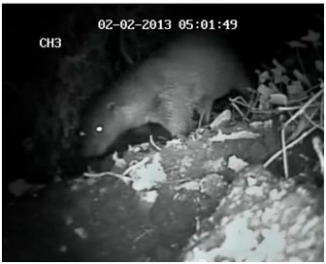This week the volunteers went birdwatching around the reserve at Winnall Moors. It was an amazing sunny day, especially after the snow of last week, with beautiful clear blue skies. On our walk we saw a Little Egret with its distinctive yellow feet, if you had seen one in Winchester 20 years ago it would have been an astonishing site that would have attracted “Twitchers”, people who travel the UK in search of rare birds. It is thought the Little Egret spread to the UK from continental Europe possibly as a result of climate change. Alas the egret was too quick for me to get a photo. We also saw the usual suspects at Winnall, such as Mallard Ducks, Moorhens, Coots, Blue, Great and Long Tailed Tits, Blackbird, Robin as well as some birds that are easy to miss such as the Little Grebe or Dabchick which searches for molluscs, invertebrates and small fish in the river.
Despite carefully scanning the river and listening out for their distinctive whistle we didn’t succeed in spotting a kingfisher. However, a few days previously I did spot a Kingfisher near to the artificial nest hole. I was optimistically looking at the branches near to the nest hole when I spotted a fragment of blue through the leaves of a cherry laurel. In the soft afternoon light it was hard to tell what the source of blue was, could it be litter, as is often the case along river banks in urban areas? Or was it light catching the shiny leaves of the laurel? I thought if I watch this mysterious piece of blue for a minute or so and it moved then I new I had a kingfisher. And move it certainly did, diving into the river then flying to a nearby perch with a fish in its bill, which it preceded to beat on the branch it had just landed on whilst orientating the fish head first into its mouth.
Stomach full the bird flew onto a stake I had placed outside the entrance hole for such purposes. My heart was in my mouth as I watched this brilliant flash of blue dart briefly in and out of the nest tunnel. After dirtying its plumage in the tunnel the bird did a shallow dive into the river shaking off the water and soil from its feathers as it took off.
It is still early in the season and this was just a lone male so this is no definite sign that Kingfishers will use the nest this year, but it is great to know that at least one kingfisher knows the nest box is there. Fingers crossed for the spring.

A male kingfisher watching over the river. You can tell its an adult by the bright orange/red toes and that its a male by its lower mandible (lower jaw) is black, on a female this would be orange. Copyright Dave Eades.
Here’s the latest footage from the cameras at Winnall Moors including voles, Blackbirds as well as Otters:



